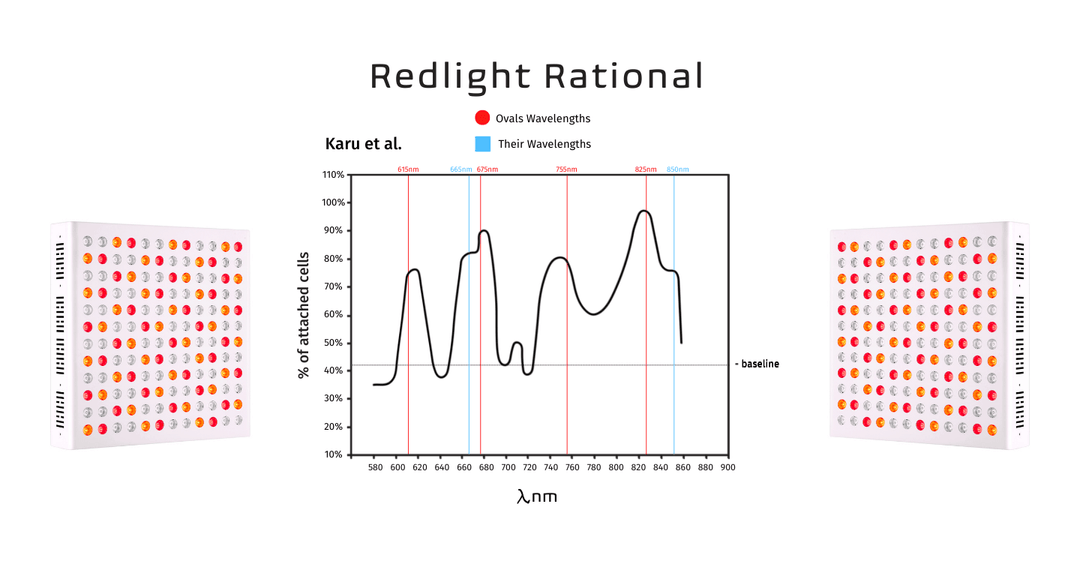Authors: Andrew Chow, Michael, Kiamanes, Carla M Parsons
In summary, Redlight Therapy employs photobiomodulation, leveraging light to modify biology. Numerous peer-reviewed studies affirm red light’s capacity to boost ATP production within cells, leading to improvements in cognitive function, wound healing, collagen growth, skin condition, and muscle recovery. Explore Oval’s strategic wavelength selection for optimal efficacy.
Full Article:
Red light therapy, or photobiomodulation, applies specific wavelengths of red and near-infrared light to the body within Oval’s life extension pod. The measurable red light spectrum, spanning 600 to 800 nm, includes both visible and invisible near-infrared light beyond 1000 nm. This practice is colloquially known as ‘red light therapy,’ and all references on this page follow this convention for simplicity.
Red light, superior due to its ability to increase ATP production via the photoreceptor molecule Cytochrome C. Oxidase and elevate Mitochondrial Membrane Potential (MMP), outshines other colors like green or blue with more muted therapeutic effects. [1][2] Increases in ATP production and MMP from red light therapy offer scientifically demonstrated benefits, including enhanced cognitive function, wound healing, collagen growth, skin condition, and muscle recovery.
Our pod combines unique wavelengths for optimal restorative and regenerative benefits of red and near-infrared light therapy. Based on published scientific research, the chosen wavelengths (625-635 nm, 670-680 nm, and 810-830 nm) promise maximum therapeutic benefit. Peer-reviewed studies reveal these wavelengths yield favorable outcomes in terms of cell adhesion, increased lymphocyte receptor sites, cell attachment, and DNA synthesis. [3][4][5][6]
These results are crucial, demonstrating cells positively respond to red light within specific wavelength ranges. Cells contain photoreceptors responding more favorably to certain red and near-infrared wavelengths than others. Figure 1 visually represents a cell’s reaction to a specific wavelength, emphasizing ideal wavelengths concentrated at peaks. [7] Note: for customer readability, the original linear graph was converted to a non-linear format for front-facing displays, such as the header image and second graph.
Cell Adhesion as a Key Metric: Unveiling the Impact of Red Light Wavelengths on Therapeutic Outcomes
Unlocking Effective Red Light Therapy: The Crucial Role of Optimal Wavelengths in Cell Adhesion
The study underpinning Figure 1 scrutinized cell adhesion, a vital metric reflecting cell growth and responsiveness to red light. This measure is pivotal for tissue maintenance, exerting a profound influence on overall body systems. At optimal red light wavelengths, cell adhesion could peak at nearly 100% (around ~830 nm), while reaching its nadir in the range of 30-40% (~580 nm and ~720 nm), occasionally dipping below nonirradiated control levels [8]. Notably, a mere 20 nm deviation (~850 nm) from the zenith resulted in a significant drop to 60% cell adhesion. In practical terms, this highlights that even a slight departure from the optimal wavelengths (as little as 20 nm) can profoundly impact the efficacy of red light therapy a user experiences. This emphasizes why the selected wavelength in red light therapy stands out as one of the most critical determinants of success.
Advancing Red Light Therapy: Exploring the Impact of Wavelength Variance on Therapeutic Efficacy
Navigating the Spectrum: Red and Near-Infrared Wavelength Exploration in Scientific Research
While extensive scientific exploration has delved into the concept of illuminating the body with different colors, particularly focusing on various red and near-infrared wavelengths as independent variables, such studies remain relatively scarce. In contrast, most investigations in red light therapy primarily scrutinize the impact of a single wavelength within the 600 – 1000 nm range on a specific variable of interest.
Dr. Tiina Karu stands out as a pioneering researcher in the realm of red light wavelength variation, being among the first to delve into optimizing wavelengths within the red and near-infrared spectrum. Her studies, along with others, affirm the pivotal role of wavelength in red light therapy, highlighting a pronounced disparity in therapeutic efficacy with even a minor 10 nm change in certain ranges.

Precision in Wavelength Selection: Enhancing Therapeutic Efficacy in Red Light Therapy
“Rather than relying on historical precedent or cost, Oval prioritizes finding the most effective red light therapy wavelengths. Our unique combination maximizes benefits at 625 nm ± 5 nm, 675 nm ± 5 nm, 810 nm ± 5 nm, and 830 nm ± 5 nm in a 1:1:1:1 ratio. This differs from competitors using approximately 660-670 nm and 850 nm. Overlaying Figure 1 highlights the subpar effectiveness of these wavelengths. While the difference between 665 nm and 675 nm is subtle, the notable inferiority is evident at 850 nm compared to 830 nm (cell adhesion of nearly 100% and 70% respectively) (Figure 2).

Optimizing Therapeutic Impact: The Role of Wavelengths and Ratios in Red Light Therapy
Enhancing Red Light Therapy Efficacy: A Multifaceted Approach
While wavelength stands out as a primary determinant of red light therapy efficacy, at Oval, we advocate for additional strategies to optimize therapeutic outcomes. Beyond varying the wavelengths, the relative quantity of each wavelength becomes a crucial consideration. Moreover, individual red and near-infrared wavelengths offer unique benefits. Combining multiple effective wavelengths can amplify overall therapeutic effectiveness [9]. This rationale guides our panel design, featuring a 1:1:1:1 wavelength ratio, with each panel containing 144 LEDs, including 36 LEDs for each wavelength. Consequently, this balanced ratio ensures that no wavelength overwhelms others, maximizing therapeutic benefits.
Sources:
[1] https://pubmed.ncbi.nlm.nih.gov/28798481/
[2] https://pubmed.ncbi.nlm.nih.gov/8833286/
[3] https://pubmed.ncbi.nlm.nih.gov/15362946/
[4] https://pubmed.ncbi.nlm.nih.gov/14872239/
[5] https://www.jstage.jst.go.jp/article/islsm/10/2/10_2_55/_article/-char/en
[6] https://pubmed.ncbi.nlm.nih.gov/8833286/

